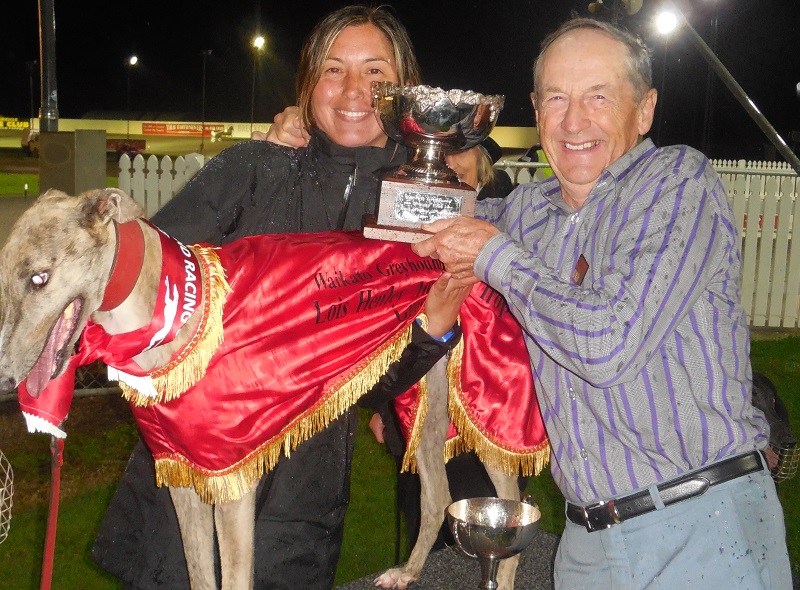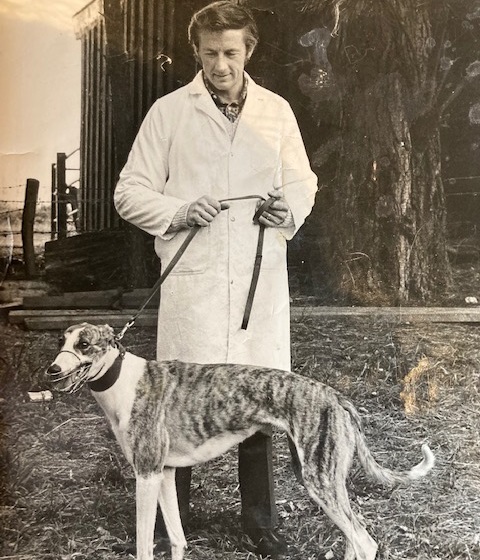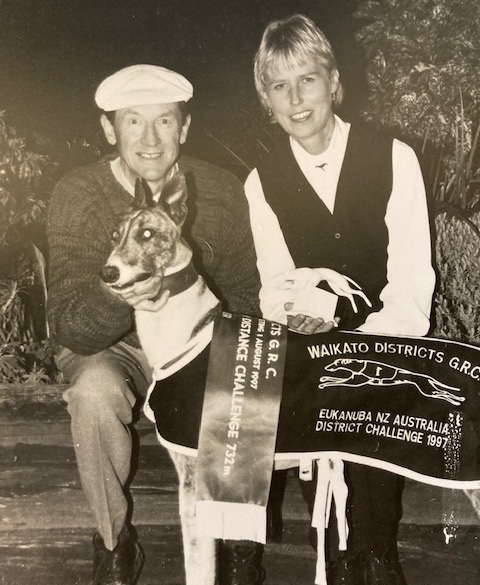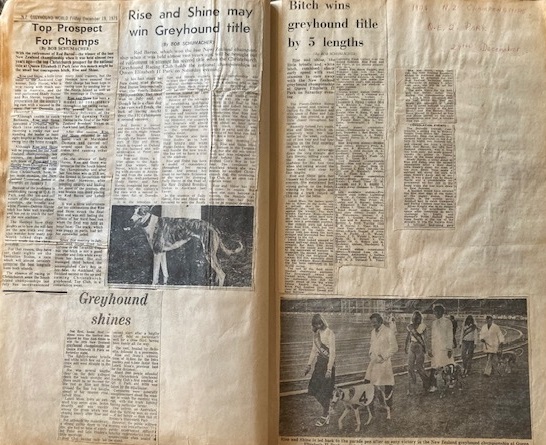Peter Henley retires after 50 years in greyhound racing

Pictured: Peter Henley has made the decision to retire from greyhound training. Photo credit: Peter Fenemor.
In the new season, a familiar name will be absent from the training ranks.
After some 50 years of involvement in greyhound racing, Peter Henley will be hanging up the collar and lead. Henley’s name is synonymous with the sport, having trained with his late wife Lois for a number of decades.
Born on 4 February 1941, he grew up in Westport and had a love for racehorses from an early age.
“I started riding gallopers in trackwork for a couple of trainers before I went to school in the mornings,” he remembers.
“Then, I got involved with doing some work for a trotting trainer, but I didn’t like driving trotters because it was so bloody long. You’d jog a horse one way for 30 minutes, then the other way for 30 minutes; I’d nearly fall asleep!” he laughs.
After Henley met Lois, they explored their shared passion for pigeons together.
“We had racing pigeons together in Westport and when we moved to Oxford (Canterbury) in around 1969, we set up a pigeon club there.
“Then, the greyhounds came along, and that started about 50 years of involvement with them.”
Their introduction to greyhound racing was an accident. The couple had three young children, and the kids used to climb through the fence to play with the neighbour’s dogs.
“Our neighbour, greyhound trainer Jock Walsh, always had pups. There was one pup who always used to follow the kids home and that’s how it started.”
After a visit to Marshlands Domain, Henley was fascinated by the dogs’ intelligence and the way they intuitively knew what paths to take when they were racing. He was instantly hooked.
“So, we bought this little pup from next door, and we called her Rise And Shine. The kids used to put her in a pram and cover her with blankets and push her around the backyard,” he chuckles.
“She lived in the house because if we put her in a kennel, she’d find a way of getting out. She lived inside and slept on the sofa with the cats.”
Rise And Shine wasn’t just the family pet – she won 35 races, including the 1975 New Zealand Championship at QEII Park.
In those days, greyhounds could start their racing careers at a very early age.
“They could actually start racing when they were nine months old,” says Henley. “There were races for sapling dogs between 9 and 12 months old, and puppy races for those between 12 and 15 months old. It meant that they got a lot of experience before they went up the grades against other younger dogs.
“In those days, older racedogs could sometimes race twice in one day!”
Since those early days with Rise And Shine, Henley has never been without a greyhound – and there have been plenty of highlights over the years.
“We bred our own dogs from that first greyhound. When she was mated, we went to the best dog in Australia at the time. With every litter, there was always one good enough to go back and race in Australia.
“One of the best ones was a dog called Bright And Shiny,” he recalls. “He was broken in at Tokoroa, and as a break-in, he broke the track record there. We knew he was the goods and then we took him to Mount Smart for a race there and he broke the sprint record, but they didn’t give it to him because they said a maiden dog couldn’t do that.
“He won 13 races straight in New Zealand before we sent him to Australia. One of the top Sydney commentators at the time said he was one of the few New Zealand dogs that had come over who could hold his own on the city tracks.”
Henley went to Australia a few times to watch the dog race there in person. Back in New Zealand, tuning in to listen to Bright And Shiny race in Australia wasn’t easy; racing coverage back then wasn’t like what it is now.
“The only way you could hear these race commentaries in Australia was to tune into Radio 2UE Sydney. We’d be up at 1am huddled around the radio, trying to listen to the race.
“But Radio Samoa had just started on the same frequency, and that would come in and overshadow the race commentary!”
In 1979, the husband-wife training combination took out the Auckland Trainers’ Premiership, which Henley cites as a major highlight.
“It went right down to the last meeting of the season at Mt Smart, and we were neck and neck with Bob and Delys van Meeuwen all season. They were really good trainers and hard to beat in those days, so it was a major feather in the cap achieving that.”
In the 1980s, Henley was on the Auckland Committee, and he remembers the Minster for Racing at the time, Allan Highet, being on track to present a trophy.
“It was a Trans-Tasman series featuring greyhounds from throughout Australasia. We had Bright And Shiny in the race, but our daughter Carolyn was also the caretaker trainer of a greyhound trained by the Kingstons building up to the race.
“Well, that dog ended up beating Bright And Shiny in the final – Carolyn did too good a job looking after it!”
He fondly remembers the opening of the all-weather track at Cambridge in 1997. The New Zealand Australia Distance Challenge was held on opening night, and their dog got up to win in the last stride.
“The whole grandstand was packed and it took quite some time for the judges to come to a decision in the race. When it came through that Jimmy Dash had won by a nose, the whole grandstand must have been on him, judging by the noise!”
While Henley and Lois were firmly entrenched in the racing side of things, the pair also became heavily involved in the administration side, with Lois becoming a pioneer for animal welfare in the sport when she was on the Greyhound Racing New Zealand Board. She was also the Secretary of the Waikato Greyhound Racing Club, while Henley was the President there.
“We both had a wonderful time, really. In the early times, animal welfare wasn’t as much of a focus. The progress made in this area over the years has been great to see, and Lois was one of the early instigators.”
While Henley, aged 81, has decided now is the right time to finish up as a greyhound trainer, he’ll still be kept busy in retirement. Now, he’ll have more time to spend on his other passion – pigeons.
He speaks enthusiastically about the birds. When he was in Queenstown a few weeks ago for his granddaughter’s 21st birthday, he took the opportunity to collect a couple of pigeons from a friend in Manapouri.
“Those two I picked up are yellow. I’ve never had yellow birds before, but it’s good to have variety.”
Colour is an important aspect of pigeon breeding, he explains.
“You have a fair idea about breeding for colour. For example, if you breed a red bird to a blue bird, a lot of times you’ll get a sort of silver-coloured bird.
“You’ve got to mate them for looks, and that also includes how they stand and that sort of thing – it takes quite a bit to get a good-looking bird. I quite like the birds that are called blue bars; they’re blue and have two black bars on each wing.
“There are hundreds of different pigeon breeds around the world. I think that some breeds are bloody ugly, but each to their own!” he laughs.
Henley currently has around 35 pigeons at his property, and he knows who every single one is by sight.
Last month, he took a number of them down to Levin for the National Poultry and Pigeon Show, where his prized pigeons claimed two coveted titles: ‘Best Pigeon in Show’ and ‘Reserve Best Pigeon in Show’.
“I was a bit chuffed about that!”
“Lois loved putting scrapbooks together. It’s lovely going back through and looking at the past.”
Henley admits that after Lois passed away in 2011, his interest in greyhound racing dwindled slightly, as they “did everything together.”
“Malin, my new wife, has been wonderful, though. She didn’t know anything about greyhound racing, and now she’s very confident and helps Carolyn with retired greyhounds.
“This is probably the end of an era a bit for me. I feel like I’ve played my part in the industry, having been actively involved as a trainer and also in the administration of it. It’s great to see the new generations coming through – some of the trainers doing well now, I can remember from when they were kids. We always loved helping out the younger generation."
Henley is also quick to express his gratitude to a number of people in the sport.
“Thank you to the trailblazers, who fought long and hard to finally get tote betting for our industry. Many have passed on, but they would be happy to see their efforts rewarded with a multimillion-dollar industry today.
“And a special thank you to the former Minister for Racing, Winston Peters, for creating a level playing field for all three codes.
“I’ve loved my time in the sport. I’ve made a lot of friends here and in Australia. Age catches up with us all – I’m just lucky I’m in reasonable health so I can enjoy my birds!”
By Liz Whelan


